We had missed sighting it the past 3 days, and our neighbor Scott also had not seen it at the spot the crane liked to visit, just across the street from his home. As usual, Mary Lou walked up ahead of me while I took a few "shots in the dark..." well, semi-darkness. She continued the full 1 1//2 miles into the wetland preserve and then returned home at her customary fast pace.
An immature Little Blue Heron hunted along a row of sedges. Under-exposed, I liked the color cast by the filtered light of dawn in the still air.
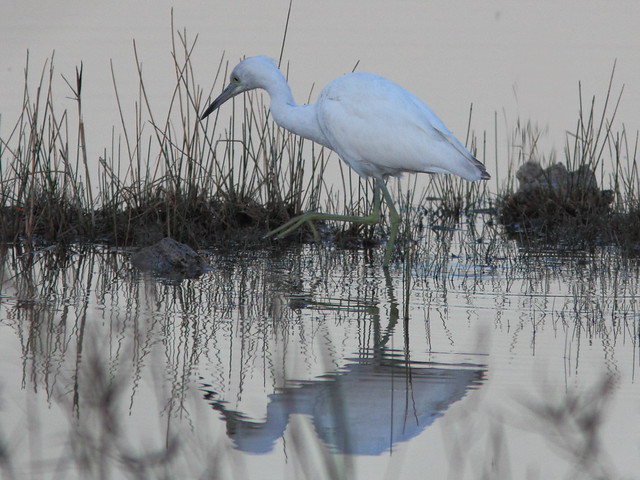
This Osprey was silouhetted against the sky, and when I processed the shot I had to push the brightness all the way up.
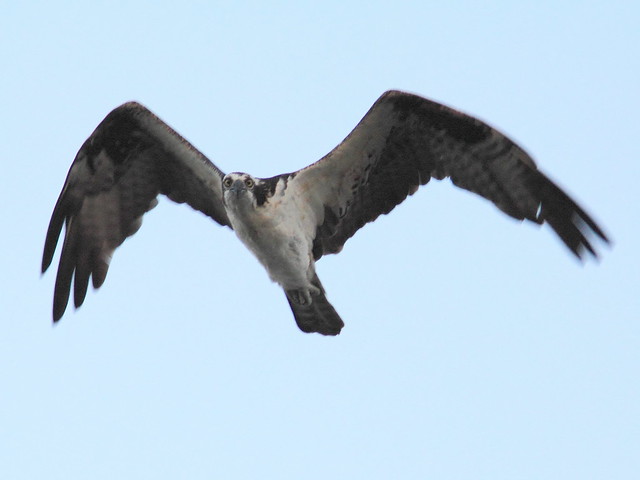
I kept vigil, hoping I had gotten there before the crane departed for its foraging grounds. Looking towards the Everglades, to the west over the lake, the sky had a pre-dawn glow. I tried to overlook the deep tracks in the mud flats, created by the ATV riders. The crane usually emerged from a field just in front of the green trees to the far right in this photo.
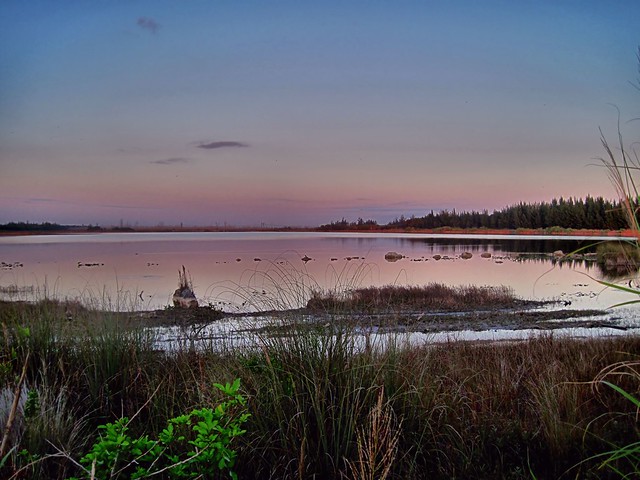
My cell phone rang. It was Mary Lou, telling me that she had met two wildlife specialists at the entrance gate, Jeanette and Ricardo, from the Whooping Crane Eastern Partnership. They were asking about the crane. She related that I was about 1/2 mile up the gravel road, looking for it. The gate was locked and they could not access with their truck, so they rode their bicycles in. On the way in, they picked up the signal from Cypress-- in the direction of my neighbor Scott's home. Jeanette was carrying the receiver and antenna when she pedaled towards me. This crane did not carry a satellite locator, so ground reports were important to allow the researchers to know the general area in which they might track it with the short-range equipment.

I texted Scott and he confirmed that the crane was indeed on his front lawn. We entered the Harbour Lakes subdivision and encountered the crane just across the street from Scott's house.
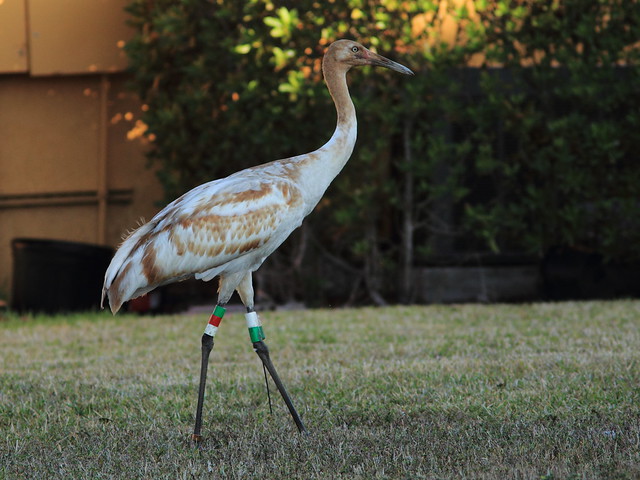
Jeanette spent over an hour gaining the crane's confidence. Several times it appeared spooked when pedestrians and especially those walking dogs came by. She fed the crane green grapes and corn.
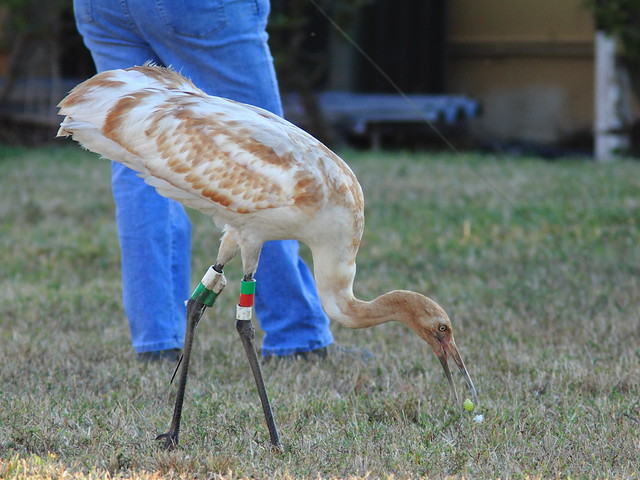
It stepped in and out of the snare but Jeanette wanted a perfect capture. Her body language calmed the crane. She never walked directly towards the bird, but rather approaced it at an angle and usually looked away from it.
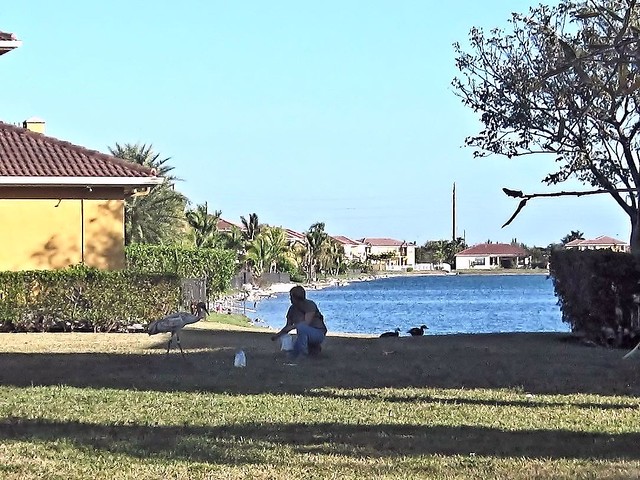
Several feral Muscovy Ducks and White Ibises joined in the feeding. Auto traffic increased as parents transporting children to schools and commuters heading to work moved by rapidly. We had to divert pedestrians, as the crane showed signs of being alarmed and prepared to fly. Then, the crane started walking away, across the road.
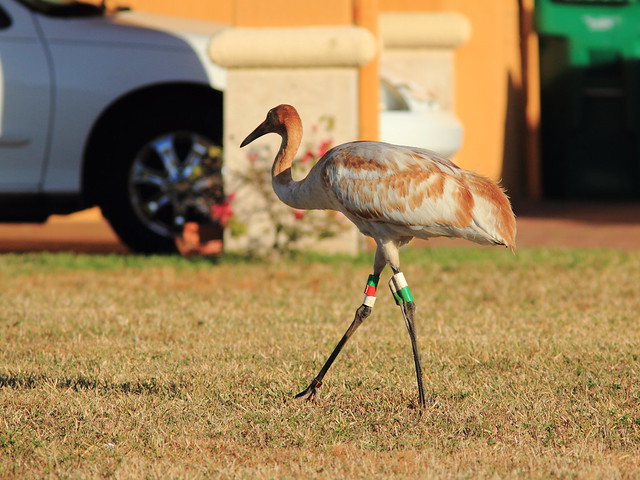
Jeanette donned a white sheet similar to that used when the cranes are reared, as it hides the human form.
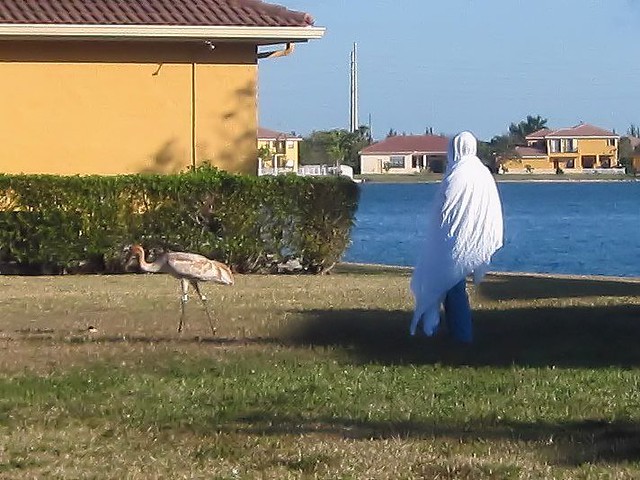
The crane actually came running to her! Within minutes the crane was captured. Here is a short video showing the entire sequence of events (Correction-- my lens system is 420 mm, not 720 mm-- I use a 300 mm + 1.4x extender).
Scott took this photo of Ricardo and Jeanette at the conclusion of the capture. It is ironic that it was Scott who first photographed the crane after its arrival in the wetlands, and now he took the final photo to document its departure. (© 2013 Scott McPherran, used with his permission).
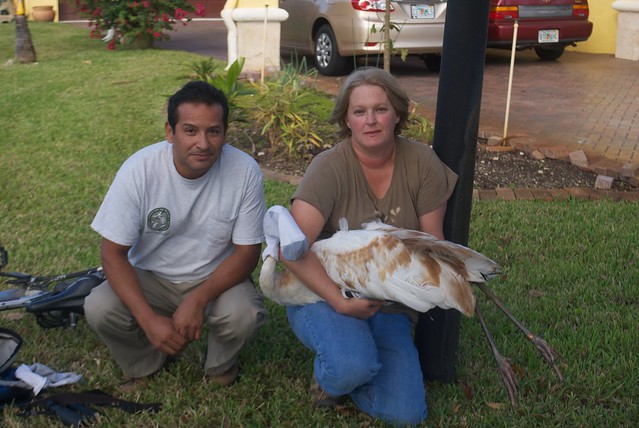
Soon Cypress was safely on his way to join a mixed flock of adult Whooping and Sandhill Cranes in the Lake Okeechobee area.
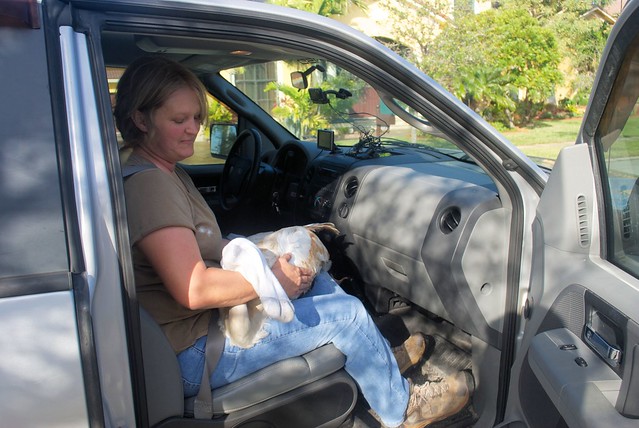
The female crane #13-12 ("Tussock") recovered and was earlier released in Tennessee (See the interesting local newspaper account here). A US Fish and Wildlife news release with a video link may be viewed here.
While I am excited about the possibility that an Eastern migratory population of Whooping Cranes may be established by this program, I must admit to some concerns about this captive-bred crane. These birds are shielded from human contact while they are raised. They are fed using crane puppets and not exposed to human handlers unless the latter are draped in white sheets to hide their identity. (View WCEP slide show on training captive cranes.)
Perhaps it would be better if they learned to fear humans at some point before being released into the wild. These two birds permitted many people to approach them very closely, including youngsters on ATVs. Lacking fear of humans, they visited suburban lawns and even walked up to people. Might it have been a good idea to teach them that humans should be avoided? What if the first people they saw shot off firecrackers or clanged pots and pans to frighten them? Perhaps this would discourage them from approaching human habitations, and yet permit them to adapt to a more urbanized winter habitat.
Great post, Ken! I so glad there was a happy ending to the Crane story. Great post and photos.
ReplyDeleteso glad this one was reunited with a flock - hoping he continues to do well. bless those patient capturers.
ReplyDeleteWhat an amazing experience especially so close to home. I hope Cypress does well with the flock.
ReplyDeleteA job well done by all concerned Ken.
I LOVED reading this!!! How super. I am so happy that there was a good outcome. Bud and I found a family of three Whoopers this past week, and even tho I wasn't able to get close enough without a good zoom lens, I at least got to see them in the wild!! I've been trying for three years. I will post about them next week on my photo blog. AND!!!!!!!!!!!!!!!---
ReplyDeleteI'll be darned!!!
Working on cooler colors in the automatic color balance in my installed program [I don't have photoshop] worked. I guess it's a good thing to remember the time of day the photos are taken. But yes, I do believe it looks much more a 'likeness' of the Parula now. Thanks for the tip. I will have to remember it. Very much appreciated.
Are you back home now, with a good internet connection?
@Anni--Thanks! No, we are still in Illinois, hoping that our daughter will be able to put weight on her right foot after she sees the doctor this week. Her husband will try to get to the office for the first time in over three months. Their Internet connection is so slow that our granddaughters watch the screen and sing "Loading, Loading, Loading" to the tune of "Rawhide." (It took me 5 minutes to write this reply).
ReplyDeleteRemarkable post Ken with a lot to think about. I am glad of course that the ending was happy for now, but your point about the fear factor being important is well taken!. I see by your comment above that you are still in Illinois and I will go back and re-read this post to see when it happened. We will be going to the Lake O area next month for a few days but by boat; probably won't be able to see these birds.
ReplyDeleteBest wishes to all there in Illinois and take care of your ownselves too!
Thank you thank you thank you for these reports!!! I am glad that everyone is back on track again. People scare me around wildlife...especially those close to extinction. Sometimes they don't know just how precious and fragile these birds are. This made my day and I appreciate all your wonderful reporting on the beginnings and conclusion to this story. I am planning on a trek to Wisconsin again this year and will hopefully be able to check out Necedah which is near my parent's home. All my best. Chris
ReplyDeleteI hope you and your family are well and happy Ken.
ReplyDeleteAmazing photos of the crane and its capture and it's so interesting to hear about the perils for a captive bred bird. I've read the reports of how those birds are raised and then taken down south but had never thought about the problems of them not knowing that human activity should be avoided. Great post - and thanks from all your readers that you persisted with the very slow internet connection.
ReplyDeleteWow what an exciting sequence!! Boom & Gary of the Vermilon River, Canada.
ReplyDeleteInteresting reading, great post!
ReplyDeleteGreat image series showing. Want days a good day. Thanks for the comment on my blog :) Hanne Bente
ReplyDeleteGreat story! I wish our birds with transponders on them would run towards us!! No such luck.
ReplyDeleteCheers
Stewart M - Melbourne
Interesting post does not begin to describe this! What an awesome opportunity you had, and captured it wonderfully!
ReplyDeleteThank you for your input on my "Eagle or Hawk" post. I think the red-tailed hawk won the most votes! Thank you again!
it is a beautiful bird but I feel sorry for it. I hope everything works out the way it is supposed to.
ReplyDeleteFantastic documentation of the adventures of Cypress! Thanks for updating us, Ken!
ReplyDeleteWonderful post!
ReplyDeleteI so appreciate your efforts and sadly have to say that with the approval of the KY government Sandhill Cranes can now be killed which will also impact the Whooping Cranes, and my heart just aches for the stupidity of man! Please take care and know that I love these great birds and your images and care are appreciated by me!
ReplyDeleteThanks to you all for your encouraging comments! Things are settling down a bit here in Illinois, and Eureka! I have normal Internet. (Comcast blamed it on work they have been doing on the lines for the past two weeks. Just hope they are finished!)
ReplyDeleteI'm glad to hear Cypress is settled for now, but appreciate the concerns stated at the article's end. Hope all turns out for the best....
ReplyDeleteJust got word that female #13 (Tussock) has died, and at this time the location of male #15 (Cypress) is unknown.
ReplyDelete